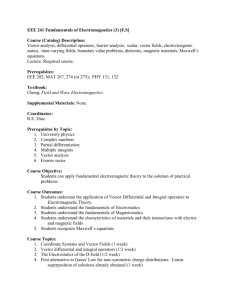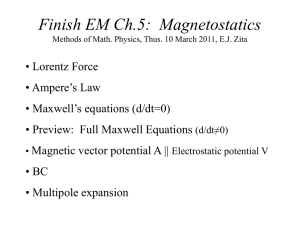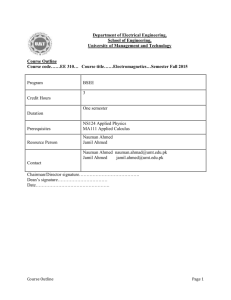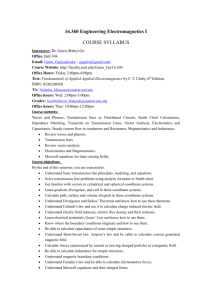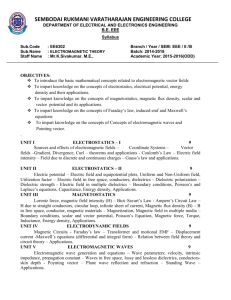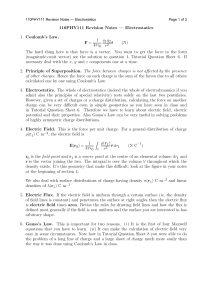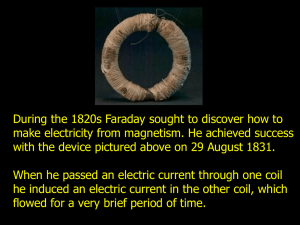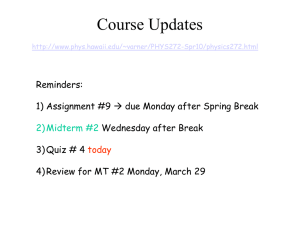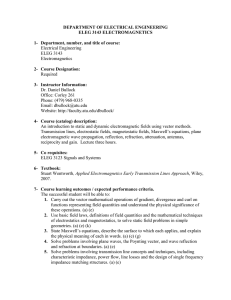EIE311 Electromagnetics Course Compact - Covenant University
advertisement
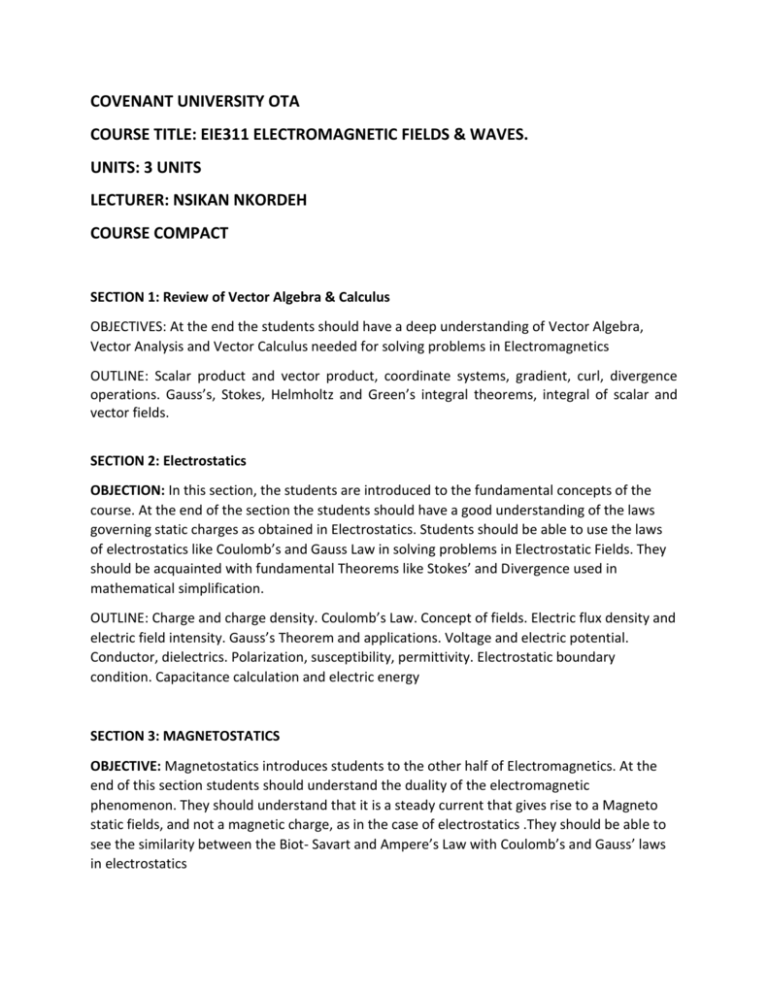
COVENANT UNIVERSITY OTA COURSE TITLE: EIE311 ELECTROMAGNETIC FIELDS & WAVES. UNITS: 3 UNITS LECTURER: NSIKAN NKORDEH COURSE COMPACT SECTION 1: Review of Vector Algebra & Calculus OBJECTIVES: At the end the students should have a deep understanding of Vector Algebra, Vector Analysis and Vector Calculus needed for solving problems in Electromagnetics OUTLINE: Scalar product and vector product, coordinate systems, gradient, curl, divergence operations. Gauss’s, Stokes, Helmholtz and Green’s integral theorems, integral of scalar and vector fields. SECTION 2: Electrostatics OBJECTION: In this section, the students are introduced to the fundamental concepts of the course. At the end of the section the students should have a good understanding of the laws governing static charges as obtained in Electrostatics. Students should be able to use the laws of electrostatics like Coulomb’s and Gauss Law in solving problems in Electrostatic Fields. They should be acquainted with fundamental Theorems like Stokes’ and Divergence used in mathematical simplification. OUTLINE: Charge and charge density. Coulomb’s Law. Concept of fields. Electric flux density and electric field intensity. Gauss’s Theorem and applications. Voltage and electric potential. Conductor, dielectrics. Polarization, susceptibility, permittivity. Electrostatic boundary condition. Capacitance calculation and electric energy SECTION 3: MAGNETOSTATICS OBJECTIVE: Magnetostatics introduces students to the other half of Electromagnetics. At the end of this section students should understand the duality of the electromagnetic phenomenon. They should understand that it is a steady current that gives rise to a Magneto static fields, and not a magnetic charge, as in the case of electrostatics .They should be able to see the similarity between the Biot- Savart and Ampere’s Law with Coulomb’s and Gauss’ laws in electrostatics OUTLINE: Current and current density. Magnetic dipoles and current loops. Magnetic flux density and magnetic field intensity. Biot-Savart Law and Ampere’s Law, Faraday’s Law. Magnetostatic boundary condition. Self and mutual induction. Inductance calculation and magnetic energy. SECTION 4. Maxwell’s Equations OBJECTIVE: In this section student will be introduced to one of the most important concepts of Communication fundamentals- the Maxwell’s equations. Student should be able to appreciate Maxwell’s equation for its usefulness in explaining Faraday’sand Ampere’s law OUTLINE: Time Varying fields: Faraday’s Law of Induction, the conservation of charge and the incompleteness of Ampere’s Law. Maxwell’s equations and Lorentz force law. Uniform plane waves and wave equation. Time harmonic fields. Polarization of waves. Poynting’s Theorem and the conservation of energy, the field definitions of impedance, admittance. Phase and group velocities SECTION 5: WAVES IN MEDIA OBJECTIVES: In this section, students are introduced to the propagation of waves in different media other than free space. They should understand how Maxwell’s equation could be applied in solving problems of dielectrics and permeability. OUTLINE: : lossy media, dispersive media. Wave Propagation and Transmission Theory: Boundary conditions. Reflection and refraction at plane interface (normal and oblique angles), transmission line analogy SECTION 6: TRANSMISSION LINE THEORY OBJECTIVE: In this section, students are introduced into the concept of transmission line, differentiate the analysis of lines operating at normal frequency as seen in circuit theory from lines operating at high frequencies. They should also be able to use the Smith Chart in solving transmission line problems. OUTLINE: differential equations for a general transmission line, low loss and lossless lines, impedance characteristics of lines with various terminations, simple mismatch problems and the use of Smith Chart. Introduction to Waveguides and Cavity Resonators GRADING FOR THE COURSE Test 1= 15% Test 2=15% Exam=70% Total=100% RECOMMENDED TEST BOOK Engineering Electromagnetics by Williams Hayt Jr and John A Buck 6th Edition McGraw-Hill
